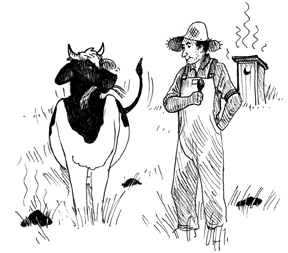STRANGE BUT TRUE-Phew! Steer clear of skatole

Q. I grew up on a farm and the smell of ripe manure in the barns never offended like the human variety. What gives? –T. Jefferson
A. Probably this stems from cows and horses being herbivores, humans carnivores. The distinction even shows up in babies: breastfed, they give a milder smell, but with the coming of solid foods, especially meats, things change.
Skatole (3-methylindole) is the offender, to which the human nose is sensitive and which may repel us because excrement can transmit disease, says New Scientist magazine. But the stuff doesn't trigger disgust in everyone, and the reaction is not shared across the animal kingdom.
Moreover, even though most animals avoid their own, many relish that of other species, such as wild dogs coveting the droppings of jackals, and hyenas following after both. Chicken manure is valuable cattle feed, and in a pinch, rabbits will ingest the droppings of cats.
Astounding facts: skatole (from the Greek "skat" for dung) is used in perfumes as a fixative, to prevent too-rapid evaporation, says Robert Wolke in What Einstein Told his Barber. In low concentrations it has a flowery smell, found in essential oils of orange blossoms and jasmine. It also turns up in small amounts in food flavoring, notably in vanilla ice cream (the scoop on poop)!
Q. "I sing the body electric," celebrated the 19th century poet Walt Whitman. In what ways are today's doctors "singing" right along with him? –B. Murray
A. It all began in 1786 with Luigi Galvani, Italian anatomist who found that if two different metals were connected and their open ends touched to the muscles of a dead frog, these would contract, says John R. Cameron in Physics of the Body. Galvani thought the dead frog generated the stimulus, but today we know better. What he had inadvertently done was to create a rudimentary battery.
Essentially all functions and activities of the body involve electricity in some way, even muscle forces that are done by the attraction of opposite electrical charges. The body puts out a host of signals tracked by doctors using a host of different machines: an ECG (electrocardiogram– heart), EEG (electroencephalogram– brain), EMG (electromyogram– muscles), ERG (electroretinogram– retinas) and EOG (electrooculogram– eye muscles); also magnetic signals recorded by an MCG (magnetocardiogram– heart), and MEG (magnetoencephalogram– brain). Body electric-magnetic indeed!
Q. If all goes as planned, what's destined to be placed in the "Doomsday vault"? Clue: Think 10,000 years of plant breeding and a Noah's Ark for seeds. –J. Chapman
A. The vault's actually a large room hewn out of a mountain on the Norwegian Arctic Island of Spitsbergen, 1000km from the North Pole, says Fred Pearce in New Scientist. The meter-thick walls of reinforced concrete will be protected behind airlocks and blast-proof doors. The point is to safeguard around two million seeds– representing all known varieties of the world's crops– in case of nuclear war, climate change, terrorism, rising sea levels, earthquakes and the ensuing collapse of electricity. This would allow reconstruction of the planet's agriculture. The project is directed by the Global Crop Diversity Trust, an independent international organization.
Even if catastrophe forced abandonment of the vault, the mountain's permafrost would keep the frozen seeds viable, even against global warming. "It's a fail-safe depository, rather than a conventional seed bank," said director Cary Fowler. "Essentially," reads the feasibility study, "it will be built to last forever."
Q. What happens if you let a helium balloon float up into the sky? Will it a) reach outer space? b) burst as the air thins? c) descend back to Earth after reaching a certain altitude? –F. Dimension
A. A kid's birthday balloon might go up a mile or so before it starts to descend as the helium leaks out. Some research balloons have a strong outer shell that allows them to rise to a certain level and stay there, says University of Hawaii meteorologist Steven Businger. Others made of stretchy material like polyurethane will expand as they rise and eventually burst.
Weather balloons– aka radiosondes– and their payload of instruments descend by parachute after the balloons burst. Some larger ones stay in the stratosphere for long periods to collect data, with commercial applications like communications. "No balloon will escape the Earth's atmosphere because they can't reach escape velocity of approximately 25,000 mph!" Businger says.
Send Strange questions to brothers Bill and Rich at [email protected].
#